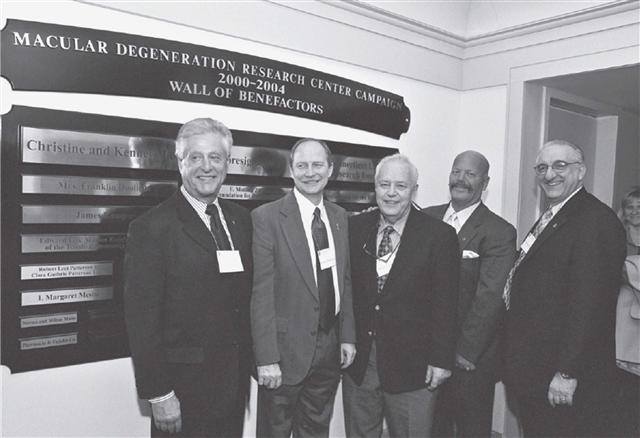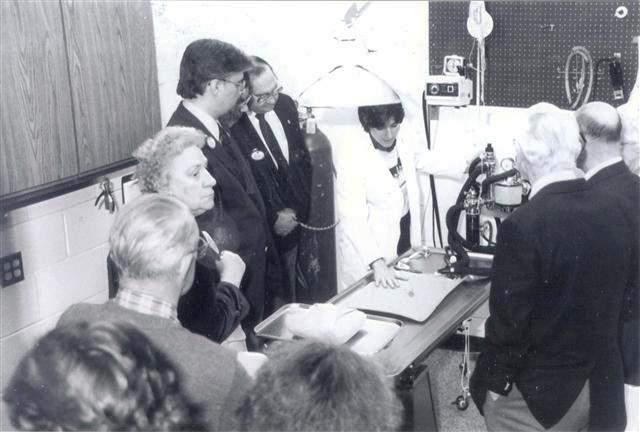History of the Connecticut Lions Eye Research Foundation
The year was 1953, and the Connecticut Council of Governors had a vision; a vision of a major project that would bring all the clubs of Multiple District 23 together, to act as one to fight blindness.
The Council appointed a committee to investigate several possibilities.
The committee found that there was a huge amount of money directed towards the blind; however, a very small percentage was allocated toward finding the cause of or cure for blindness. Actually only one percent of all monies allocated were being spent on research.
The committee asked the Council for approval to establish the “Connecticut Lions Eye Research Program.” This was later changed to the “Connecticut Lions Eye Research Foundation.”
During the Connecticut Lions State Convention held at Lake Copake in New York June 6, 1954, the delegates of Multiple District 23 voted to establish an eye research clinic. The facility would be under the auspices of the Yale University Department of Public Health and located at the Yale University School of Medicine in New Haven. It would, however, be necessary for three-quarters of the clubs to agree to contribute at least three dollars per member, but no more than five dollars per member during the next five years. This was accomplished and reported at the Mid Winter Conference on February 12, 1955.
The founding officers were President Harold Ashley, PID; Vice President Richard Case, International Counselor; Secretary, A. Leroy Anderson, International Counselor and Treasurer Spencer B. Hirst, International Counselor.
Several notables were honorary members of the board including Connecticut Governor Abraham Ribicoff; TV show host Ed Sullivan; Vernon Lippard, Dean, Yale University, and Stanley Osbourn, Connecticut Commissioner of Public Health.
A charter for the foundation was issued by the State of Connecticut on July 20th, 1956, designating the Connecticut Lions Eye Research Foundation as a non-profit corporation.
In 1961, Marvin L. Sears, M.D. was hired as a full time Director of Research, and served in that position until July 1993. Today the Department of Ophthalmology and Visual Science is under the direction of James C. Tsai, M.D., Chairman. M. Bruce Shields, M.D. served as Chairman from 1996 until October of 2006.
It is interesting to note that Yale, during the early years, set aside 100 square feet for a laboratory and provided Dr. Sears with one assistant. Today the research facilities at Yale have a staff of over 25, and are housed in their own multi million-dollar facility, the Boardman Building, which the Connecticut Lions helped to renovate with a $500,000 donation. It is in this building that the Connecticut Lions Eye Research Foundation maintains an office. Research at Yale has resulted in the development of “Timolol” which has been found to be very effective in the treatment of glaucoma. As the foundation grew, our involvement extended into other areas. Through the efforts of Dr. James O’Rourke, the Lions’ Eye Center, a second research facility, was created at the University of Connecticut’s Farmington Medical Center. In 1974 Dr. O’Rourke announced the launch of a Micro Vascular Retinal Imaging Project using Lions grants. As a result, a screening program for children with juvenile diabetes was developed using the equipment and technology developed from that project.
Through grants from our foundation, organisms recovered from laboratory mice and Australian cattle aided in the development of a cure for river blindness.
Several hospitals in Connecticut have been the beneficiaries of Lions’ grants, allowing for example, the purchase of equipment to facilitate various types of eye surgery.
The Foundation, in the beginning, primarily relied on annual club donations and income from “SightSaver” Day (formerly called “Lions Day” or “Candy Day”). When the Foundation needed additional funds for the Boardman Building project, the car raffle was introduced. Since that time, both the memorial card and recognition card programs were introduced, as well as the annual golf tournament.
Today funds are being raised through the 21st Century Fund as well as the “Knight of the Blind” awards. Beginning in 1990, it was the Foundation’s hope to raise $2,100,000 by the year 2000. Since that time, the Foundation extended the target date to coincide with the Foundations 50th Anniversary. This money would be the base endowment for a fund that would insure that we would be able to meet the future needs of the blind and visually impaired.
The Connecticut Lions Eye Research Foundation has had a magnificent history, providing funds that have allowed scientists to continue to work so that one day, together, we will find a cure for all forms of preventable blindness.

Lions Sydney Schulman, PCC; Robert Redenz, PCC; Rocky Cingari, PDG; John Gagain, PDG; and Michael Del Re, Jr. PDG gather at the Wall of Benefactors recognition plaque that honors that major donors of the CT Lions Macular Degeneration Research program at the Yale Eye Research facilities in New Haven

Connecticut Lions are presented with a tour of the Eye Research facilities at the University of Connecticut Medical Center in Farmington.
History of the CLERF held PGA Event
In August of 1996, the Connecticut Lions Eye Research Foundation hosted an existing PGA event at the Woodway Country Club in Darien. The event raised approximately $110,000 for the single day event, and attracted several well known professional golfers to our state.
The event began with an early morning shotgun golf tournament, where amateurs teamed up with local section golf teaching professionals. The top sponsors were teamed up with Senior PGA touring pro Larry Nelson, who later became the tour’s top money winner in 2000. The Senior PGA renamed itself the Champions Tour in 2002.
After lunch, a Skins Game format tournament began, featuring Golf’s great Arnold Palmer, Peter Jacobsen, Mike Hill and David Frost. David Frost was a favorite, since he was the 1994 Greater Hartford Open winner. Mike Hill was the Senior PGA top money winner in 1991. Peter Jacobsen later became the Greater Hartford Open winner in 2003; and has always been a favorite in Hartford.
The Skins Game was sponsored by Southern New England Telephone. It attracted a crowd of over 3,000 spectators, who followed the foursome through the game through the early afternoon.
This project was first proposed by Lion John Boscarino of the Windsor Locks Lions Club, who, working in concert with the officers of the Foundation, developed and planned the event for at least two years before hosting a pilot golf event early in
1994, featuring golf legend Arnold Palmer. This smaller event proved that the Connecticut Lions could develop a major event and led to the later skins game format. Lions from all three Districts participated in making these golf events the most successful fundraising activities held by the Foundation since its inception in 1956.




